Growing and caring for a host in the open field: planting in spring, summer and autumn
Hosta is one of the few rhizomatous plants that are especially prized for the beauty of the leaves, not the flowers. Moreover, as soon as it is not called - and funky, and a giant plantain!
So that the flower, amazing in the variety of shapes and colors of foliage, does not suffer from stress and gives the joy of admiring itself for a long time, you need to be puzzled by the right choice of a seedling, timely and competent planting, as well as caring for it in the open field.

Content
Purchase, preparation and storage of hosts before landing in open ground
Very often, most plants appear on sale already in February-March, when they still cannot be planted in open ground, which means that if you buy a host so early, you will have to somehow save it before planting, and first choose the most viable specimen ...
Choosing a seedling (rhizomes) when buying
Before buying a hosta, it is advisable to carefully (rolling the soil inside the bag from side to side) and carefully examine its rhizome through the packaging (as a rule, it is sold in bags with a nutrient mixture).
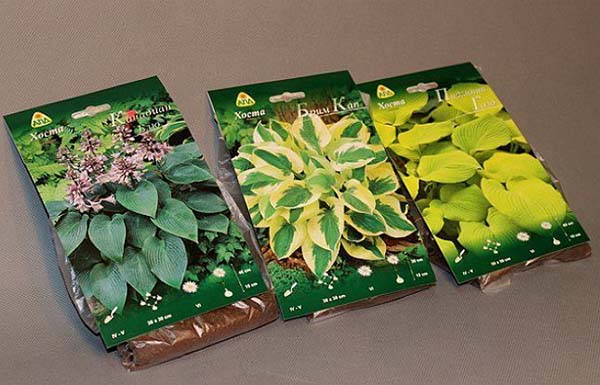
They (roots) should be light, relatively long and not overdried, but also not waterlogged (if there is a drop of condensation on the package), in other words, healthy, without any signs of disease (rot).
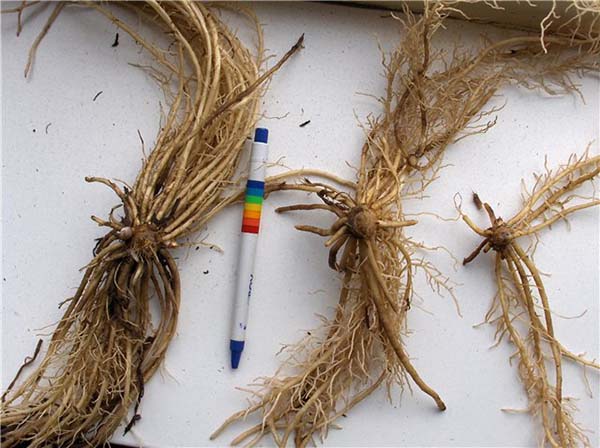
note! If you see that kidneys still dormant, You can remove the rhizomes for storage in the refrigerator, on the bottom shelf. However, it is better to plant them in a pot right away, especially if the sprouts have already begun to grow. If the seedlings are kept in the refrigerator for a long time, they will stretch out, become pale and may rot.
Preparation and processing of rhizomes (soaking them)
Naturally, before planting rhizomes in the ground, including in a pot, they need to be processed, namely disinfected or restored in a growth stimulator (if they are not in very good condition).
Important! If there are dead, rotten or diseased areas on the roots, they should be cut off first, and then soaked in fungicide.
So if you see that plant roots are very dry (overdried), then they can be soaked in one of the growth stimulants, for example, in Zircon, Epine or HB-101 (according to the instructions).
In general, in any case, rhizomes cansoak (disinfect) in a solution of potassium permanganateand even better Fitosporin.
Landing in temporary tanks
Step-by-step instructions for planting hosta rhizomes in a pot:
- Lightly fill the container (1-2 liter pot) with neutral acidity soil (it is optimal to buy a universal one or make it yourself from peat, forest soil, sand or vermiculite).
Note! The pot should have both drainage holes through which moisture will leave, and the drainage itself (expanded clay).
- Place the roots there, trying to spread them evenly and distribute them inside the pot so that they do not bend too much.
Advice! If the roots are very long, it is best to cut them off.
- Fill up with the remaining soil.
Important! The tip of the sprout should remain slightly on the surface.
- Spill with water (room temperature), or even better with a solution of potassium permanganate or phytosporin.
- Sprinkle lightly with earth again so that a dry crust does not form on top.
- Next, be sure to put it on a light windowsill. If this is not the case (the northern one does not fit), you need to supplement the lighting.
However, if you do not want the plant to grow too quickly, then you can leave it on the northern windowsill. And even better in this case, keep the pot in a cool place, for example, on an insulated balcony or loggia (but not in direct sunlight).
Further, before planting in open ground, all you need to do is monitor the humidity (the soil should be slightly damp, not soggy), remembering to water periodically.
And before planting (for a week or two), you should start hardening, gradually taking the pot with the plant out into the open air (outside), but not into the sun's rays. The light must be diffused, otherwise the host will burn out.
Video: early purchase of hosts, its preservation and preparation for disembarking in the garden
When to plant a host in open ground: optimal timing
The most suitable time for planting hosts in open ground is spring, when the ground warms up enough and the threat of return spring frosts has already passed. Thus, the approximate dates are the end of April-May.
Note! The host can be planted in summer. However, this is done either at the beginning of summer and is also called spring planting, or already at the end - this is already an autumn planting.
In the middle of summer, landing (transplant) it is not recommended to deal with plants, except for container ones.
You can also plant hosta in early autumn, i.e. around September or even earlier. It is not recommended to plant later, because the plant may not have time to take root and take root before the onset of sub-zero temperatures.
According to the lunar calendar in 2021
It can help you choose the best date for disembarkation Moon calendar.
So favorable days for landing hosts in 2021 according to the lunar calendar are:
- in March - 4-6, 12-14, 26-31;
- in April - 1, 2, 5-7, 9, 13-15, 24, 25;
- in May - 2-6, 15-17, 20, 21, 25-31;
- in June - 2-4, 6-9, 11-14, 23-25;
- in July - 6-11, 13-16, 23-29;
- in August - 5-7, 20, 21, 23-25, 27-30;
- in September - 9-11, 15, 16, 19-21, 26-28;
- in October - 6-8, 21-23;
- in November - 9-13, 22-24, 27, 28.
Unfavorable days according to the lunar calendar for 2021 (the days of the Full Moon and New Moon, as well as the period when the Moon is in Aquarius, since this is a barren and dry sign -italicized) for boarding hosts are the following dates:
- March -9-10, 13, 28;
- in April -5-6, 12, 27;
- in May -2-4, 11, 26, 30-31;
- in June -10, 24, 26-27;
- in July -10, 24-25 (24 - also Full Moon);
- in August -8, 20-21, 22;
- in September -7, 16-17, 21;
- in October -6, 13-15, 20;
- In November -5, 10-11, 19.
Planting hosts outdoors: a step-by-step guide
Hosts are quite unpretentious to growing conditions, but nevertheless, when planting them, some rules should be observed: choose a place with suitable lighting and soil composition, and also plant rhizomes (seedlings) correctly.
Place in the garden
It is optimal for the hosts to find a place in the area of the garden protected from the sun and wind. Generally, the best for this is place in partial shade.
If the leaves of the hosta are constantly fluttering in the wind, they will naturally look unsightly and untidy.
For example, it can be the north side of the house or fence, the shadow of the crown of tall trees or shrubs (you can plant it right in the tree trunk circle).

What is partial shade? This is when the sun hits the selected area only in the first or second half of the day (4 hours or more). But exactly for hosts better when the sun illuminates the plant exactly in the first half of the day.
By the way! The place is considered shady (shadow)if it is illuminated by the sun during the day within 2-4 hours, either only in the morning - from sunrise to 8 am, or only in the evening - after 4 pm and before sunset.
But some variegated (variegated) host varieties still love the sun, but not all:
- Varieties with leaves with white border better to plant all the samein partial shade (but not a shadow), otherwise the border will simply fade in the sun.
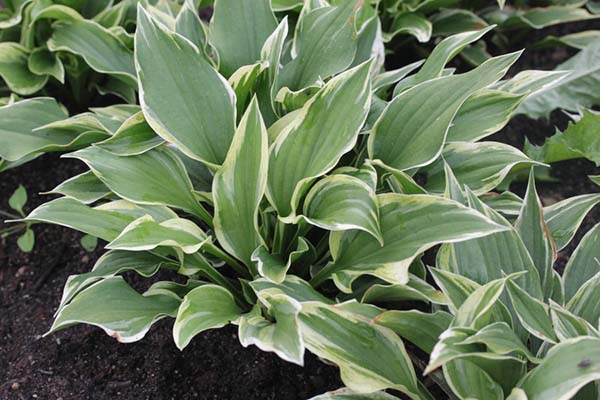
- It's another matter if the leaves have a light center: such varieties can be planted on relatively sunny areas of the garden (with light partial shade). The same goes for hosts that have completelywhite or yellow leaves, i.e. they lack chlorophyll.
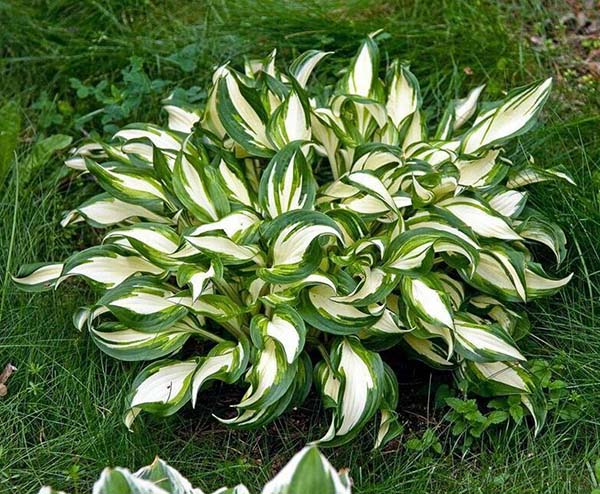
Worth knowing! In open places, where the sun will fall on the hosts both in the morning and in the evening (especially all day), the plants will look rather untidy and scanty, and grow poorly. They will have to be watered and fed more often.
And here blue and blue hosts should be planted exclusively in partial shade, better even in the shadowotherwise, under the scorching sun, their blueness will simply disappear over time.

By the way! The host is sometimes called the queen of the shady garden or the queen of the shade. ABOUT other plants that can or like to grow in the shade, you can find out by reading this article.
Suitable soil
Of course, hosta can grow on any soil, but prefers to open up in all its glory only on wet and loose soils (well-drained)which rich in organics, in other words, onhumus soils... As for their acidity, they will do neutral or slightly acidic soils.
Note! Excessively sandy or clayey (heavy) soils are highly desirable to somehow improve and / or loosen.
Alternatively, you can add humus or compost, peat, complex mineral fertilizer to the planting pits, mixing everything thoroughly with the garden soil.
Direct landing
Step-by-step instructions for planting hosts in open ground:
- Choose the best place in the garden - in partial shade or shade.
- Prepare a planting pit and apply organic fertilizers (humus, compost).
- Put in the hole and spread the roots, if you are planting with rhizomes, or simply pull out the plant along with an earthen clod and put it flush with the soil level.
- Cover with soil and compact.
- Water thoroughly and abundantly.
If the earth settles, add and water lightly again.
- Mulch with peat, bark or sawdust.
If you decide to plant several plants, then the hosts should be placed at a distance of at least 30 cm from each other, depending on their future size (variety).
Video: how to properly plant the host
Taking care of the host in the open field
Hosta is considered to be a very unpretentious and shade-loving plant that only needs to be watered. All other agrotechnical measures are carried out exclusively at the request and need of the gardener (feeding, transplanting and dividing the bush).
By the way! As a rule, nothing grows under the hosts, which means that you free from boring process like weeding near the trunk circle from weeds.
Video: features of growing and caring for a host - rules and realities
Watering
Note! It is believed that the only thing that can actually kill the hosts is drought.
However, according to gardeners, the host can tolerate it (even in the sun, without watering and rain). But, of course, in the sun and with occasional watering, the plant will not look gorgeous.
Just don't think that the host doesn't need to water at all. The fact is that moisture does not evaporate so quickly in the shade, which means that watering can be very rare, especially since, as a rule, they (hosts) have enough natural moisture (rainfall).
Advice! It is necessary to water the hosta exactly at the root, preferably without getting on the leaves, otherwise, due to the high humidity, they will become especially tasty for pests (slugs and snails).
It is impossible to transfer hosts, because frequent watering leads to rotting of the lower leaves.
In general, the hosts are very grateful and responsive for moderate watering.
Top dressing
In principle, if the land was originally fertile, then in the first few years no additional fertilizing is required. But in the future, in order for the plant to continue to form a beautiful and powerful bush, it will need additional nutrition - organic and / or mineral fertilizers.
It is very convenient to feed hosts by organic mulching: compost, humus, lawn mowed grass, straw, peat.
It is of course even easier to use mineral fertilizers... It will be especially important in the spring to feed the hosts with complex mineral fertilizers with a high nitrogen contentso that the plant gains green mass as soon as possible (after all, it is the leaves that are the main value of the hosta).
Advice! If you also like the flowering of hosts, then in late spring and early summer you need to additionally carry out potassium dressing by spilling the bushes with a solution wood ash or potassium sulfate (potassium sulfate).
A late summer-early autumn additional feeding can be done complex mineral fertilizerin which approximately equal ratio of nitrogen, potassium and phosphorus , for example, nitrophobic (10% each) or nitroammophos (16% each).
Pruning peduncles
Hosts tend to grow exactly for leaves, not flowersthat will simply distract attention from the leaves themselves.Therefore, it is recommended to cut off the peduncles in time (as soon as they begin to appear), especially if the bush after flowering becomes loose (sloppy), loses its shape, which means that its decorative effect decreases.
However! Flowers give a wonderful scent, especially when lightly sprayed with a spray bottle.
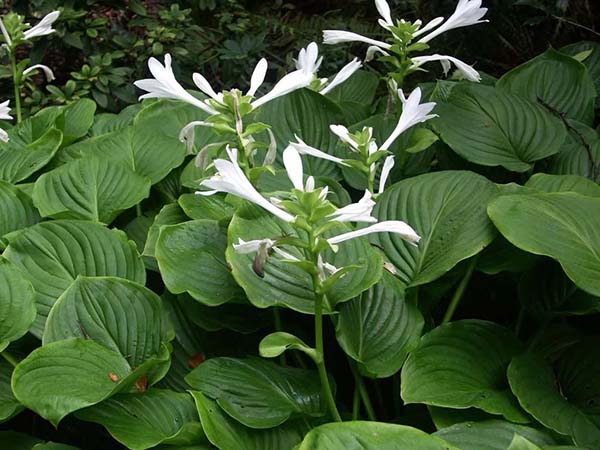
Transplant and reproduction by dividing the bush
Hosts do not need frequent transplants, but over time, the bush grows strongly and may require rejuvenation. To do this, the host needs to be dug up, and then divided into parts and planted.
Important! The site already has a detailed article about transplanting and breeding hosts by dividing the bush.
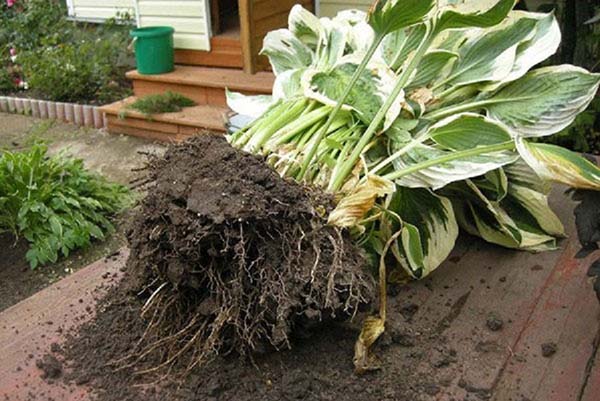
Diseases and pests
As a rule, the hosta is not affected by diseases, but the leaves of the plant are very fond of such nasty garden pests like slugs and snails.
Interesting! But the hosts Siebold slugs do not like.
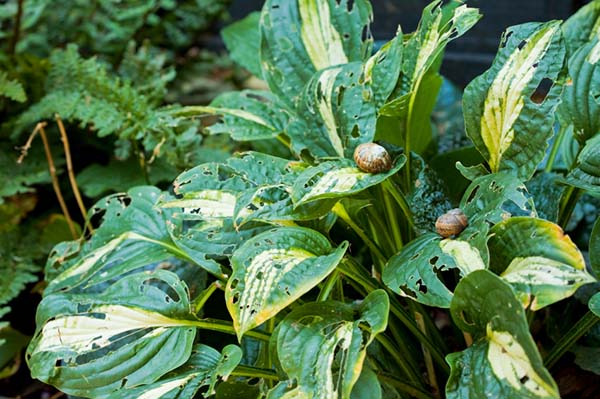
By the way! The site has a detailed article about how to deal with slugs and snails in the garden.
Autumn care and preparation for winter
By the way! About, how to properly care for hosts in the fall, described in detailin this material.
The obvious advantage of growing hosta is its high frost and winter hardiness, which means that preparation for winter is minimized.
Interesting! It is believed that the host cannot freeze out and even more so suffer during recurrent frosts. However, some gardeners (especially of the Central strip, Moscow region) still slightly cover it for the winter, and it is quite justified, because sometimes spring frosts still damage the leaves, although they grow quite quickly.
Video: preparing hosts for winter
Using hosts in landscaping
Hosts are very actively used to decorate shady areas of the garden.
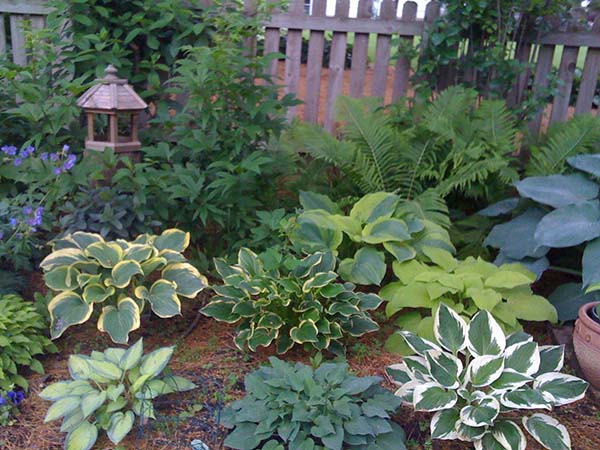
If you want to do single landings, then for this it is optimal to choose hosts high gradesthat look perfect like tapeworm plants.
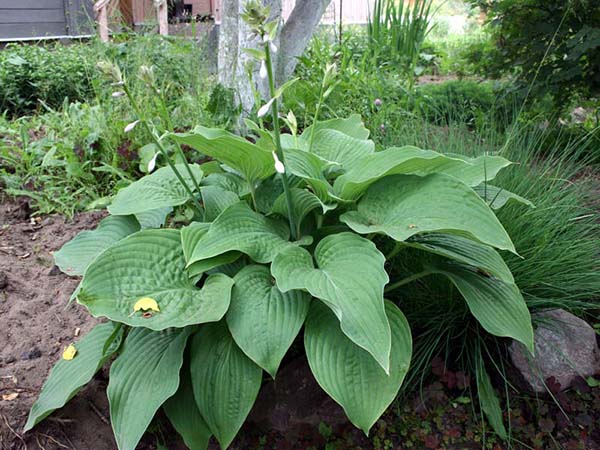
But if you want to put hosts near tracks or in curbs and mixborders, rockeries (rocky flower beds), it is better to choose undersized varieties.

Medium-sized hosts near water bodies (ponds) look very nice.
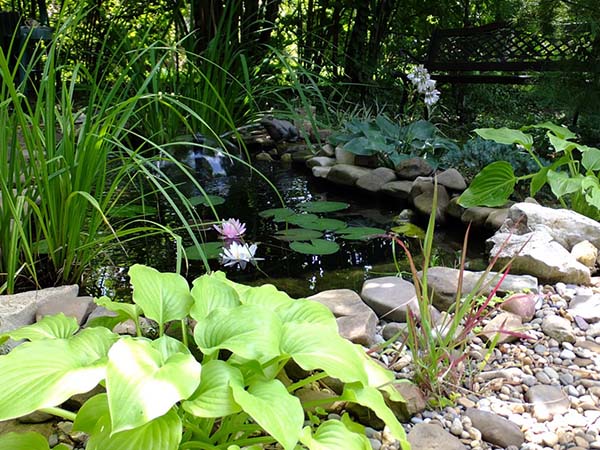
By the way! Some believe that the hosta wakes up late enough, which means that the place where the plant is planted will be empty and bare for most of the spring. You can turn this disadvantage into dignity by planting it on a flower bed crocuses, muscari, galanthus, bulbous irises (net or iridodictiums) and other primroses.
Concerning neighborhoodthen the host is fine compatible with the following plants:
- astilboy;

- geycher;

- hydrangeas;
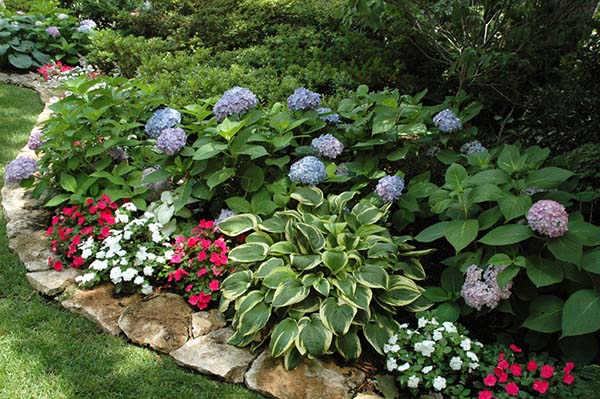
By the way! Read more aboutplanting hydrangeas in spring and in the fall.
- daylilies;
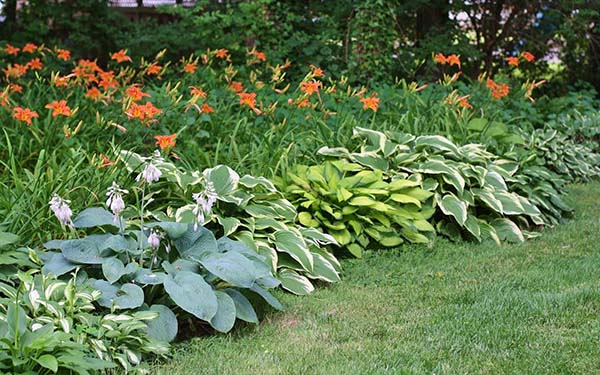
- peonies;

By the way! Read more aboutplanting peonies in spring and in the fall.
- ferns;
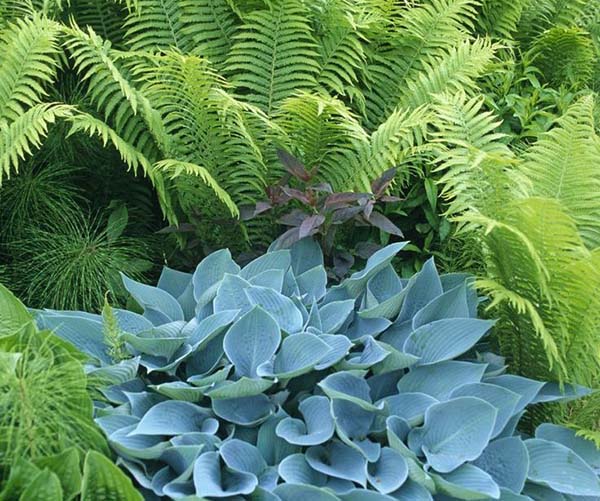
- thuami.

In other words, hosts look very nice in compositions with other shade-loving and shade-tolerant plants.
It will be very nice if you drop the hosts into the space between trees, where they will grow and gradually drown out (displace) all the grass, and you will have a kind of clearing from the host.
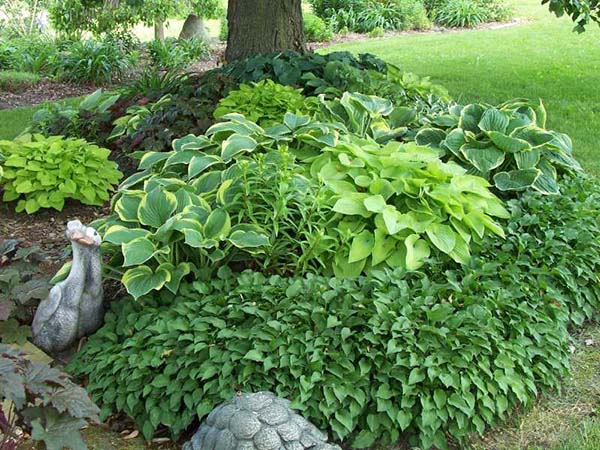
Besides open field, hosta is grown as container culture.

You will be very lucky if you decide to breed such an elegant plant in terms of foliage and flowers as a hosta in your personal plot. But in order for the health of the flower and the amount of foliage to be at the best level, it is very important from the very beginning to focus on the correct choice of a seedling, its competent planting in open ground in spring, summer or autumn and the necessary care.
Video: hosta - history, cultivation techniques and applications

